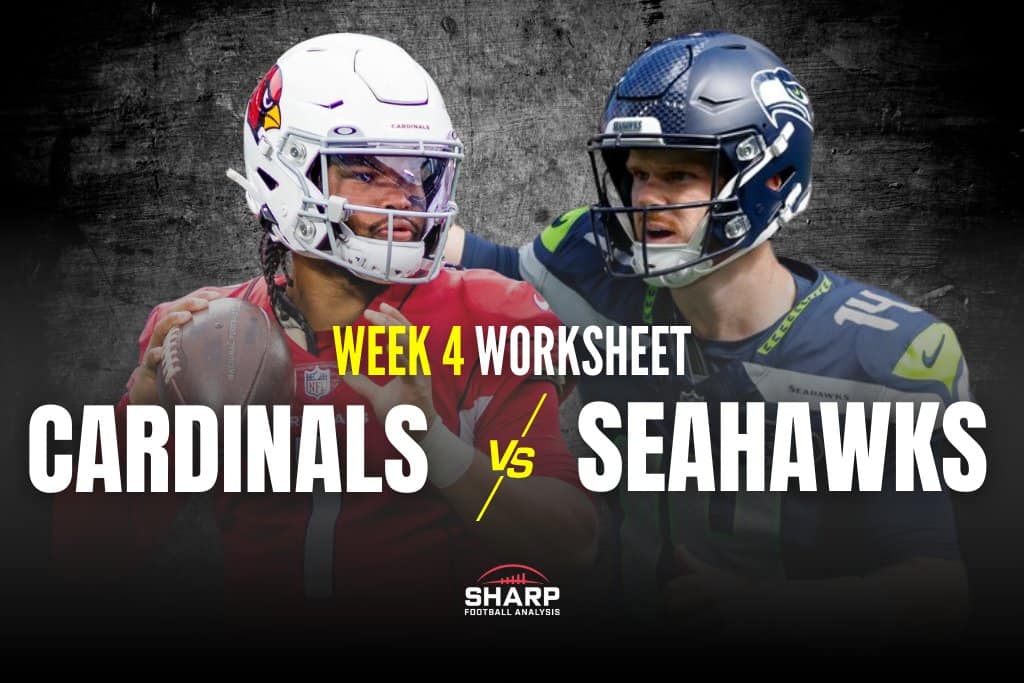The Worksheet, a comprehensive fantasy football preview by Rich Hribar, breaks down everything you need to know about the Week 4 matchup between the Cardinals and Seahawks on Thursday Night Football.
Find a breakdown of every Week 4 NFL game in our Worksheet Hub.
| Seattle | Rank | @ | Arizona | Rank |
|---|---|---|---|---|
| 1.5 | Spread | -1.5 | ||
| 21.0 | Implied Total | 22.5 | ||
| 29.3 | 5 | Points/Gm | 20.7 | 19 |
| 15.7 | 2 | Points All./Gm | 17.0 | 5 |
| 56.0 | 26 | Plays/Gm | 57.7 | 22 |
| 67.0 | 28 | Opp. Plays/Gm | 69.3 | 30 |
| 5.6 | 9 | Off. Yards/Play | 4.8 | 24 |
| 4.7 | 7 | Def. Yards/Play | 4.9 | 12 |
| 52.38% | 3 | Rush% | 44.51% | 13 |
| 47.62% | 30 | Pass% | 55.49% | 20 |
| 41.79% | 12 | Opp. Rush % | 29.33% | 1 |
| 58.21% | 21 | Opp. Pass % | 70.67% | 32 |
- The Cardinals have a 67.2% dropback rate in neutral situations, second in the league.
- Seattle has a 51.7% dropback rate in neutral game scripts, 31st in the league.
- The Seahawks have scored a touchdown on 25% of their drives, ninth in the league.
- Arizona has scored a touchdown on 18.5% of its drives, 25th in the league.
- Seattle has allowed a league-low 1.34 points per drive through three weeks.
- Seattle is the final remaining team that has not yet allowed a rushing touchdown.
- Arizona is averaging 33.0 seconds per snap on offense, the slowest pace in the league.
Trust = spike production for that player
Quarterback
Sam Darnold: Darnold has found his footing after a lackluster Week 1.
After throwing for 6.5 yards per pass attempt in the opener against San Francisco, Darnold has thrown for 8.9 Y/A and 12.1 Y/A over the past two weeks against the Steelers and Saints.
Seattle has gotten him back on track with what he does best, the play action pass.
Darnold has used play action on 33.3% of his dropbacks over the past two weeks (sixth in the league).
Using play action, he has gone 12 of 17 for 236 yards (13.9 Y/A) with 2 touchdowns.
Even with a spike in efficiency these past two weeks, Darnold has scored 15.8 and 16.7 fantasy points.
That leaves him as more of a floor-based QB2 for this divisional matchup.
Arizona has not been overly tested to open the season, but they are sixth in passing points allowed per attempt (0.317).
They have allowed 5.8 yards per pass attempt (7th) and a 2.8% touchdown rate (7th).
That was against Spencer Rattler, Bryce Young, and Mac Jones, so take that with a grain of salt.
There are avenues for Darnold to remain efficient here, even if we do not get a ceiling outcome.
We have a good idea of what to expect from Arizona.
They do not blitz a lot and want to drop back in coverage, preventing shot plays, where Darnold has thrived the past two weeks.
The Cardinals have blitzed only 17.0% of the time (28th) and have played man coverage 15.9% of snaps (22nd).
As a result, they have not gotten a ton of pass rush, generating pressure on 34.5% of dropbacks (17th).
When Darnold has been kept clean, he has connected on 37 of 47 passes (78.7%) for 446 yards (9.5 Y/A) with 3 touchdowns (118.6 rating).
The Cardinals also lead the NFL in Cover 4 rate (33.2%).
So far in the early season, Darnold is 12 of 13 (92.3%) for 11.1 yards per attempt when he has seen Cover 4.
Kyler Murray: Murray has yet to log a QB1 scoring week through three games against the Saints, Panthers, and 49ers.
Arizona has been aggressively throwing the ball, but they have not gotten the results.
They are second in the NFL in dropback rate in neutral game scripts, throwing the ball 2% more than expected in total.
That rate is 10% over expectation on first downs.
His 6.1 yards per pass attempt ranks 23rd in the NFL.
Arizona has struggled to move the ball downfield through the air.
Murray averages 5.9 air yards per pass attempt, ahead of only Aaron Rodgers (5.1).
Only 24.7% of Murray’s throws have gone 10 or more yards downfield, 29th in the league.
Murray has done his best by rushing for 35.6 yards per game, but that has only kept him as a floor-based QB2 for fantasy.
This is a matchup where it is hard to bet on a ceiling outcome.
Seattle is 11th in passing points allowed (12.1 per game), allowing 6.4 Y/A (13th) and a 3.6% touchdown rate (11th).
In two starts against Seattle a year ago, Murray was QB25 (10.3 points) and QB10 (18.0 points), throwing 2 touchdowns and 3 interceptions.
Seattle did a good job of containing Murray on the ground, allowing 9 and 16 rushing yards.
Running Back
Trey Benson: Benson is set to take over the Arizona backfield with the loss of James Conner.
With Conner off the field on Sunday, Benson played 83.9% of the offensive snaps, handling 8 of 10 backfield touches.
He ran a route on 80% of the dropbacks.
He turned 13 touches into 51 yards.
We will see Emari Demercado mixed in, but Benson is set up to be a volume-based RB2 for the immediate future.
He could grow into more than that if this running game can get on track.
Arizona running backs have a 32.7% success rate (26th).
Conner was hardly electric to open the season, but he gained yardage on 87.5% of his runs (7th in the league).
Benson is at 71.4% (31st).
Benson was more explosive to open the year, producing a run of 10 or more yards on 14.3% of his early-season runs (8th) compared to 3.1% for Conner.
Seattle has also slowed down the run, allowing 3.2 yards per carry to running backs (5th).
They are one of three remaining teams that have yet to allow a rushing touchdown to a running back.
Like Arizona, they have allowed some production through the air, yielding 15.1 receiving points per game to backs, which is ahead of only the Cardinals.
That could aid Benson if the run game continues to have issues.
Murray has thrown to running backs on 23.9% of his passes to open the year, seventh highest in the league.
Seattle RBs: Kenneth Walker: It wasn't the prettiest outing on Sunday for Walker, who turned 17 touches into 50 yards, but he did find the end zone twice to bolster his fantasy performance.
With Zach Charbonnet inactive, Walker worked as the lead back.
Before the game got out of hand on Sunday, Walker handled 8 of 9 backfield touches in the first half and 17 of 18 through three quarters.
He was on the field for 55.6% of the team's dropbacks through three quarters.
Walker has been a boom-or-bust runner, primarily due to the Seattle approach.
He ran into heavy boxes on 64.1% of his attempts, the second-highest rate among backs with 20 or more attempts.
Walker has a run of 10 or more yards on 15.4% of his runs (6th) but has also failed to gain yardage on 25.6% of those attempts (29th).
Charbonnet was already listed as a full participant for the Monday walkthrough, so things are already trending in a direction he will play on a short week.
Seattle also signed Khalil Herbert on Monday, so we will keep tabs on everything heading into Thursday.
If Charbonnet is absent again on Thursday, Walker is an upside option on the RB1/RB2 line.
If Charbonnet is back, I would favor Walker as a boom-or-bust RB2, and we will handle Charbonnet as a touchdown-dependent FLEX option.
Through two games, Charbonnet has 57 yards on 27 touches.
All of his touches are rushing attempts, garnering 0 targets.
37% of his runs have failed to gain yardage, the highest rate in the league.
As lopsided as the production was in Week 2, I am not sure Walker will pull away just yet.
Although Charbonnet has struggled as a rusher, he excelled in pass protection in Week 2, which kept him in the mix.
Arizona has played the run well to open the year, allowing 3.8 YPC to running backs with a 67.9% success rate (8th).
They have allowed 0.91 yards before contact per rush to backfields (10th).
Where they have had issues is allowing 15.7 receiving points per game to running backs, 31st in the league.
Wide Receiver
Jaxon Smith-Njigba (TRUST): JSN stayed hot on Sunday, catching 5 of 6 targets for 96 yards and his first touchdown of the year.
Seattle is dead last in the NFL in dropbacks through three weeks, but they have understood the assignment when they do throw the football.
Smith-Njigba has 40.3% of the team targets, 60% of the air yards, and has been targeted on 42% of his routes.
Those are the best rates for a wide receiver to start the season.
That is the highest target share and percentage of team air yards for a wide receiver through three weeks of a season in the 2000s.
Those rates will inevitably come down, but if we were to restart the season today, Smith-Njigba would likely be a first-round pick and is a set-and-forget WR1.
With those types of target opportunities, Smith-Njigba is going to stand out against any defensive tendency.
Following up on Arizona's high rate of Cover 4 usage to open the season, JSN has received 61.5% of the targets against those looks through three games, catching all 8 of his targets for 103 yards.
Arizona has allowed solid outings to Chris Olave (7-54-0), Tetairoa McMillan (6-100-0), and Ricky Pearsall (8-117-0) to open the year.
The Cardinals are still struggling at cornerback.
They are hoping to get Will Johnson back on a short week, but they will be without Garrett Williams for the next few weeks, as he is on injured reserve.
Marvin Harrison Jr: Sunday was a rough one for Harrison Jr.
He ended up catching 3 of 6 targets for 44 yards, with a pair of big plays left on the table.
Harrison had a shot at a 36-yard touchdown that went through his grasp.
That one at least had a degree of difficulty to it.
He then had another huge gain dropped when he was left uncovered on a deep crossing route.
Through three weeks, gamers have experienced the same touchdown-or-bust outcomes with Harrison Jr. that were present as a rookie.
After a WR13 scoring week in Week 1, he has been the WR51 and WR81 the past two weeks.
We are just looking for more stability in his floor, which leaves him as a volatile WR3.
The best thing for him is that Arizona still lacks depth among its pass catchers, so he will remain involved.
He is second on the team in targets (19.3%) and leads the team in air yards (36.6%).
In his two games against Seattle a year ago, Harrison had games of 4-49-0 (on 8 targets) and 3-47-0 (on 6 targets).
Seattle has opened the year third in points allowed per target to opposing wide receivers (1.27), allowing a 56% completion rate (4th) and 5.9 yards per target (3rd) to the position.
Cooper Kupp: Kupp grabbed 2 of his 3 targets on Sunday for 31 yards.
With Smith-Njigba dominating the target tree in a low-volume passing offense, Kupp has had a hard time finding consistent target opportunities.
He has seen 3, 9, and 3 targets to open the season.
Kupp has been on the field for 85% of the team's dropbacks; he needs more top-down passing volume for the team to be more than a WR4/FLEX.
We do have some signal here that Seattle will be involved in a tighter game.
We also have a matchup that should lend itself to Kupp having target opportunities when Seattle is throwing the ball.
Arizona has opened the season ranking 29th in points allowed to slot receivers (14.4 per game), where Kupp has played a team-high 43.2% of his snaps.
Tory Horton: Horton had a steady drumbeat all summer and has opened the season with some involvement in the offense.
He has a touchdown grab in each of the past two weeks (he also had a punt return for a score last week).
He has yet to clear more than four targets in a game since Seattle has been inconsistent in their rate of 11 personnel paired with a low-volume passing attack.
He has been on the field for 70.8%, 51.4%, and 76.2% of the dropbacks to open the year.
But when he has been on the field, he has been targeted on 22.2% and 25% of his routes the past two weeks.
Horton remains a hold in deeper formats and is best used in single-game DFS as a touchdown dart.
Tight End
Trey McBride (TRUST): Catching 5 of 8 targets for 43 yards and a touchdown on Sunday, we will not have to wait on a touchdown catch for McBride like last season.
We waited until Week 17 last year for McBride to catch his first touchdown.
McBride has opened the season with the best usage rates at the position again.
He has been on the field for 94.4% of the dropbacks with 27.3% of the Arizona targets.
Those rates are the best at the position through three weeks.
McBride was highly involved in this matchup a year ago.
He had 15 and 14 targets in the two matchups between these teams, posting games of 12-133-0 and 7-70-0.
When McBride faced Mike MacDonald's defense in Baltimore in 2023, McBride had a 10-95-1 line.
Tight ends have seen 27.4% of the targets against Seattle (6th highest) while the position has scored 31.9% of the points allowed by the Seahawks through three weeks (the highest rate in the league).
A.J. Barner: We haven't seen much involvement for the Seattle tight ends since they haven't thrown the ball much.
Barner leads the position with a route on 66.3% of the dropbacks, catching 4 of 6 targets for 49 yards and a touchdown through three games.
Barner is only an option for those chasing a touchdown in single-game DFS.

More Week 4 Fantasy Breakdowns From The Worksheet:
| Matchup | Time |
|---|---|
| Seahawks @ Cardinals | Thursday Night Football |
| Vikings vs. Steelers | Sunday -- 9:30 a.m. ET |
| Commanders @ Falcons | Sunday -- 1 p.m. ET |
| Saints @ Bills | Sunday -- 1 p.m. ET |
| Browns @ Lions | Sunday -- 1 p.m. ET |
| Panthers @ Patriots | Sunday -- 1 p.m. ET |
| Chargers @ Giants | Sunday -- 1 p.m. ET |
| Eagles @ Bucs | Sunday -- 1 p.m. ET |
| Titans @ Texans | Sunday -- 1 p.m. ET |
| Colts @ Rams | Sunday -- 4:05 p.m. ET |
| Jaguars @ 49ers | Sunday -- 4:05 p.m. ET |
| Ravens @ Chiefs | Sunday -- 4:25 p.m. ET |
| Bears @ Raiders | Sunday -- 4:25 p.m. ET |
| Packers @ Cowboys | Sunday Night Football |
| Jets @ Dolphins | Monday Night Football |
| Bengals @ Broncos | Monday Night Football |


















